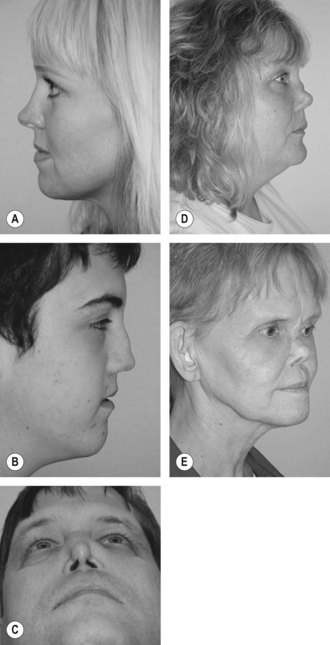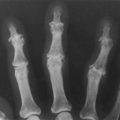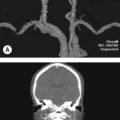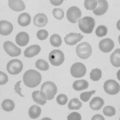237 Late congenital syphilis
Salient features
Examination
• Collapsed bridge of the nose (saddle nose or Zaufal’s sign) (Fig. 237.1)
• Corneal opacity (interstitial keratitis)
• Rhagades (linear scars at the angles of the mouth)
• Peg-shaped incisors (Hutchinson’s teeth): the central incisors are widely spaced, have a central notch and tapered like a peg
• Mulberry molars: first molars dwarfed by a small occlusal surface; characterized by roughened lobulated hypoplastic enamel (leading to caries)

Fig. 237.1 Saddle nose deformity. (A) Type 0. (B) Type I. (C) Type II. (D) Type III. (E) Type V.
(With permission from Pribitkin EA, Ezzat WH. Classification and treatment of the saddle nose deformity. Otolaryngolc Clin North Am 2009;42:437–61.)
• Check for deafness (nerve deafness)
• Look at the shins for sabre tibia
Cardiovascular manifestations have not been observed in this condition.
Late congenital syphilis is defined as congenital syphilis of >2 years’ duration.
Advanced-level questions
How is saddle nose classified?
Daniel and Brenner introduced a more detailed classification system in 2006 that classified saddle nose deformities into six different types based on clinical features and pathophysiologic processes (Fig. 237.1).
0: pseudosaddle deformity as a result of overresection of the cartilaginous middle vault
I: minor saddle nose deformity from decreased septal support but greater supratip depression and columellar retraction
II: more advanced; progressive weakening of the septal support wall leads to collapse of the cartilaginous middle vault, reduced tip support and retracted columella; internal nasal valve collapse is common
III: total loss of cartilage vault integrity and flattening of the nasal lobule; there can be nasal septal perforation, obvious flattening and depression of the middle vault and rotation of the nasal tip
IV: progressive involvement of the bony vault, leading to a pinched internal nasal valve, columellar retrusion, deprojection of the nasal tip and a short nose
V: castastrophic deformity with associated orbital and facial deformities; the tip cartilage is preserved but deformed by the relentless middle and upper vault collapse.






